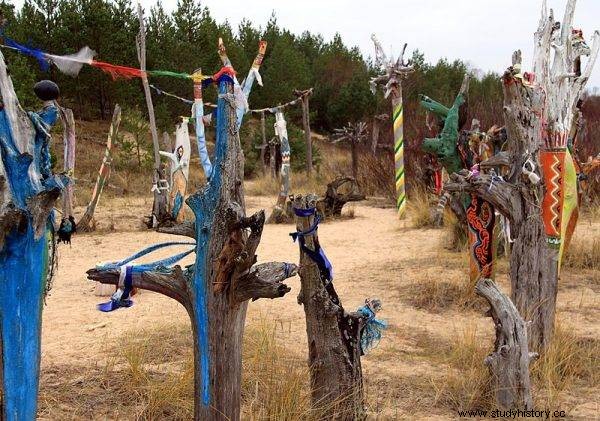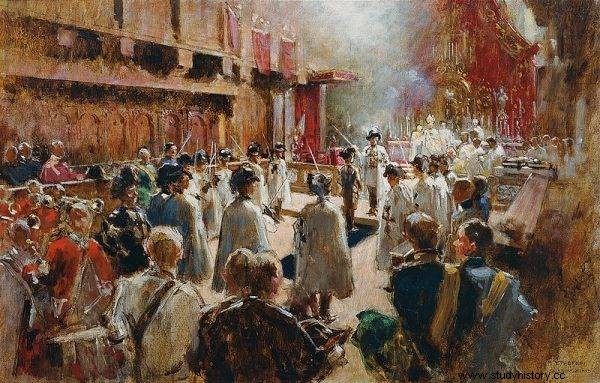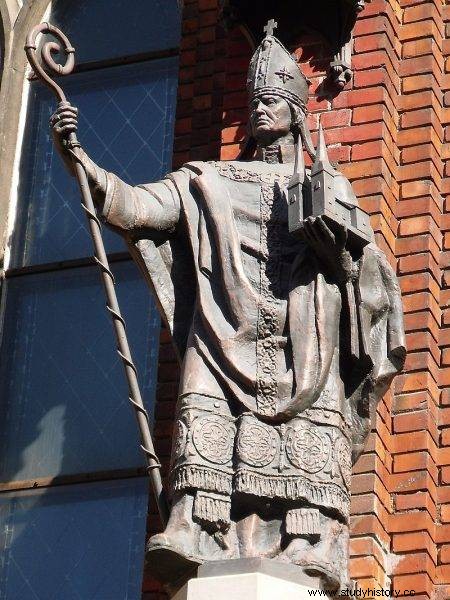Fighting in the name of Christ did not stop abuses. Livonia Sword Cavaliers deserve special attention in this regard.
"Take this sword from my hand to defend God and the country of Mary" - these words uttered by the great master of the Knights of the Sword Order seemed extremely sublime and saintly. Meanwhile, those to whom they were directed seemed to understand their meaning completely differently.
It might seem that the members of the knightly orders were noble people, pledging poverty, chastity and obedience. Their lives should revolve around prayers, fasting, and practicing martial arts and fighting against the enemies of the cross. And all this in the spirit of the medieval chivalrous ethos, which would rule out any unworthy interpretations of the rules of the Order . Unfortunately, the intentions of the founders of these gatherings were not always in line with reality. Taking vows and fighting in the name of Christ did not stop the abuse. And although all knightly orders have written less glorious pages in their history , it is the Livonian cavalrymen who deserve special attention in this regard.
To the Holy Land…
The response of the European knights to the call of Pope Urban II to liberate the Holy Land turned out to be in line with the expectations of the head of the Church. The vision of forgiveness while fighting the Saracens of earthly sins and gaining access to the gates of heaven made a great impression on a highly spiritual society. On the other hand, those for whom the expectation of posthumous rewards was not convincing enough were the expected wealth in mortality and universal recognition . After all, multitudes thirsty for salvation and earthly splendors, knights moved to the East in 1096.

The response of the European knights to the call of Pope Urban II to liberate the Holy Land turned out to be in line with the expectations of the head of the Church.
The initial successes and later troubles of Latin states made those willing to serve in the ranks of the army of St. There was no shortage of Peter for a long time. With time, the crusade movement became even fashionable, and the papal appeals to armed effort under the banner of Christ were simply obeyed.
… what for?
The trip to Outremer, while extremely enticing, was not only associated with its obvious dangers. It was also logistically demanding and extremely time-consuming. Most importantly, however, it entailed huge costs, so not everyone could afford such trips.
Relatively soon the decisions of the Clermont Synod were readily interpreted as fighting paganism in general . The spiritual leader of the crusade movement, Bernard of Clairvaux, agreed to also consider the campaigns against the Saracens in the Iberian Peninsula as the Crusades , as well as fights with pagan ... Polabian Slavs. In this way, a kind of gate was created for those who would like to join the ranks of militia Sancti Petri but the spiritual duty of fighting for the faith they would prefer to fulfill closer to their homeland.
However, it did not end with the Slavs. Soon God's blessing was given to expeditions against other pagan peoples, such as the Prussians, Yotvingians, Lithuanians, Samogitians and Liwowie living in the area of today's Latvia. The lands of the latter, called Viduzemme, which can be translated from Livonian as… Middle-earth, initially became the object of interest for North German merchants. Already in the mid-twelfth century, at the mouth of the Daugava River, they began to take over from the hands of the Livs, intermediation in the lucrative trade in the so-called the great eastern route connecting Scandinavia with Constantinople and the Middle East. The Livonian window to the world quickly attracted the German knights and, of course, the clergy.
Battles for Middle-earth
However, the mission of Christianizing Middle-earth started in 1184 by the monk Meinhard was extremely crude. Moreover, the castles and strongholds erected on his command quickly became the mainstays of the Livs' rebellion against the new religion. As a result, due to the weakness of his strength, Meinhard was forced to abandon his work. Bishop Berthold's crusade organized in 1198 had a similar effect. Although he came at the head of Saxon crusaders armed to the teeth, he paid for his mission with his life carried on Livonian swords. Left to their own devices, the crusaders did what they could best before returning home - devastated the surrounding area and forcibly converted a small group of natives.

Beginning in 1184, the mission to christianize Middle-earth was extremely crude.
Only two years later, at the head of 500 knights of the cross, another bishop of these lands, Albert von Buxhövden, undertook methodical Christianization and colonization of the land of Liwów. In the course of bloody fights, he forced them to at least formally be baptized, creating the episcopal state of the church. In addition, Albert managed to persuade Pope Innocent III to entrust the new lands to Mary. The attempt was to encourage the crusaders from the West to participate in crowds in the northern crusades in defense of Marienland.
Bad is happening in the state
Although the captured territories were soon covered by a network of trade settlements (with Riga established by Albert at the head) and castles, the Livs, attached to their beliefs, did not intend to yield easily. As a result, the bishop was forced to suppress revolts and uprisings of the local population. In addition, there were dangerous voyages of Lithuanians from the south and Estas from the north.
The problem was the constant shortage of labor, i.e. the army. Relying on seasonally working crusaders flocking to these regions to fulfill their crusade duties has not worked in the long run. Also, the civil colonization action with the help of German townspeople and clergy did not bring the expected results. Here a professional armed force available at every beck and call was needed which would organize summer campaigns with the participation of crusaders and local vassals, and in winter would guard captured defensive fingers.
New order, new trouble
In this situation, following Levantine patterns, Bishop Albert founded the Order of the Knights of Christ in 1202 (official name is Fratres Militaie Christi de Livoniae ). However, they soon began to be called - from the red symbol of a sword with a cross on the white coats - cavaliers . The new brotherhood received the Templar Rule and, like them, it was to spend our time with prayer, fasting, military exercises, and fighting the heathen. So much for the theory. The reality, however, turned out to be completely different from Bishop Albert's expectations.

The new brotherhood received the Templar Rule
Although the number of sword brothers never exceeded 200 religious, the scale of the problems related to their activity completely “compensated” for their low quality of life. Bishop Albert intended the knights to be his armed arm , serving not only to spread the faith, but most of all to increase the episcopal diocese and wealth . The territories conquered by the pagans did not come under the rule of the law, but the bishop, and only the bishop decided about the possible good for the brothers. Sometimes, instead of land, they received a financial compensation, over which they had to quarrel more than once.
Such dependence on the bishop and fighting for his benefit did not suit ambitious monastic knights. As a result, they often forcibly occupied bishops' territories, leading to feuds and accusations . Albert's attempts to pacify the situation by granting the knights a third of the lands they conquered, and then the papal order of the monks to obey the Bishop of Riga, failed. Yes, knights in habits vowed poverty, but they did not intend to cultivate this virtue.
Wealth above all
Since acquiring temporal goods in constant disputes with church authorities was slow, the knights of the sword decided to look for sources of wealth elsewhere. Yes, they continued - in line with their calling - successfully fought the pagans, converting them with fire and sword . But why risk your life and health for a dubious reward, when you could easily flaunt yourself at the expense of a conquered and already baptized population.
So they began without scruples and regularly looted bishop's estates, levied illegal tariffs on goods transported by the Daugava River, and levied horrendous tributes from the Livonian peasants, for whom they were devils in their habits . The pious brothers also did not shy away from cruising to the territory of present-day Estonia belonging to the Danes, which only complicated the mutual relations between Marienland and its neighbors.
Avalanche of vices
Historians often emphasize that the main reason for such behavior of the Knights of Christ was the highly suspect composition of the order. Organizing it properly for the immediate needs of Bishop Albert - without papal supervision and blessing - meant that adequate recruitment suffered. The vision of fighting for the faith in the poor areas of northern Europe, so different from the fabulously rich lands of the Levant, was a poor temptation. As a result, everyone who was willing to join the order was accepted . The background and motives of the candidates were the least important in this situation. In this way the members of the brotherhood did not lack all sorts of bandits and adventurers . The then chronicles even emphasized that they were exiles from the Reich, "who wanted to live their own way, without the king and without the law."

Bishop Albert established the Order of the Knights of Christ in 1202
It is not surprising then that not only drunken brawls and common crimes were the order of the day. , but also crimes of a heavier caliber . And so, just 7 years after the founding of the brotherhood, its grand master, Wenno von Rohrbach, was killed by the ax of a drunken brother. A dozen or so years later the Cistercian monastery in Dyjament near the bishopric of Riga fell prey to the knights.
They were not afraid of the temporary sabotage of the Christianization of new territories and the use of pagan Ests and schismatic Ruthenians in battles with the Danish bishopric of Lihula. And in 1230 they did not even hesitate to raise their hand to the papal legate Baldwin of Alna, who wanted to bring them to order by force. However, these efforts ended with the Knights of Christ slaughtering a hundred of the legate's men and threw him into a dungeon. Released, he soon returned to the See of Peter and brought a lawsuit against them.
Final charge
This seems to have sobered up the then Grand Master of the Knights of Swords, Volkwin von Naumburg. Feeling that the ground was beginning to burn under his feet, he asked the Teutonic Knights, who were still surrounded by a halo of impeccable opinion, to accept his brotherhood into their ranks. These, however, considered the monks of Livonia as people "indulging their own inclinations, failing to remain faithful to the rule who only want to give them a free hand and not to control their behavior, except with their consent. " So there was no question of voluntary admission.
Looking for help, Volkwin decided that the best option would be to organize a new expedition against the pagans . This was to distract his people from the robberies and make the papacy look at his order more graciously. Therefore, taking advantage of the fact that in the summer of 1236 a strong contingent of Holstein crusaders had visited Riga, the Grand Master set out against the Samogitians. However, these turned out to be an extremely difficult opponent. Successfully avoiding a major battle, they wrenched against crusade forces, which ultimately had to be content only with burning down a few villages.

A year after the defeat at Šiauliai, they were subordinated to the Teutonic Knights.
The inconsolable troops of Volkwin started their retreat. Unfortunately on September 21, in the swamps near today's Šiauliai in Lithuania, the road was replaced by Samogitian-Lithuanian forces . The Grand Master, knowing that the wetland was unsuitable for a cavalry charge, instructed his knights to attack on foot. Most of the proud crusaders would not hear of it and set up camp for the night. The morning did not change their mind.
In this situation, whether they wanted it or not, Volkwin's forces launched an attack on the positions of the pagans, who had managed to significantly strengthen their ranks (up to 4,000–5,000) during the night. The charge led by the grand master turned out to be the last one in his life. The heavy armed cavalry of the crusaders got stuck in the swamps, and the rest was done by the numerical superiority of the Samogitians and Lithuanians. The battle turned into a slaughter that claimed over 2,000 people. fallen and missing people of the Order (including 50 Knights of Christ).
End ...?
Such terrible losses in the ranks of the Sword Cavaliers left the papacy no doubts as to their further fate. A year after the defeat at Šiauliai, by the decision of Gregory IX, they were subordinated to the Teutonic Knights . From then on, they were to function as the Livonian line of this order, adopting its rule while retaining some forms of autonomy, such as having their own national master. However, it was not the end of the knights with a sword on their cloaks, who in the near future became a problem for the Polish-Lithuanian state.
